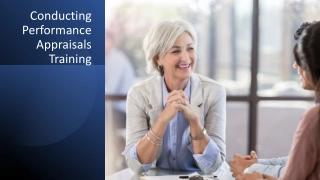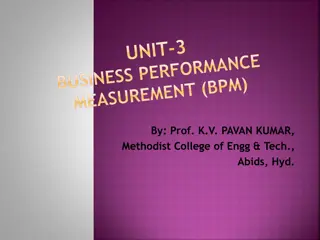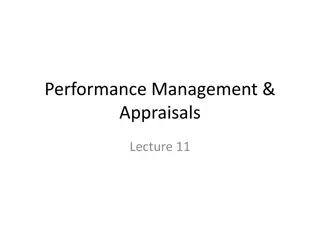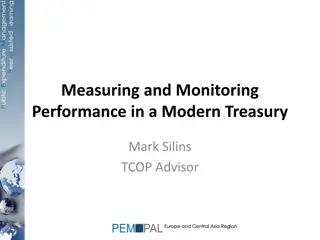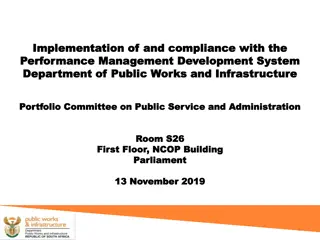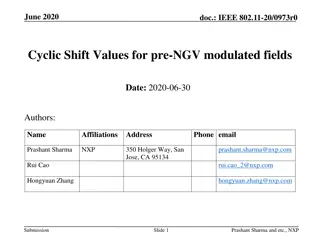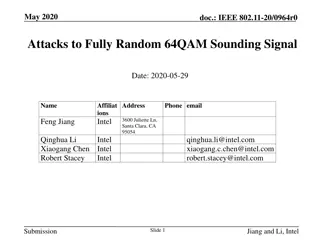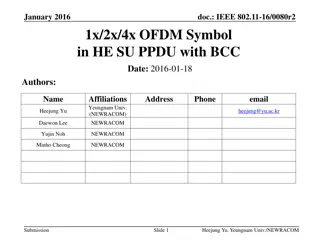
Performance Analysis of HE-LTF Density Options in IEEE 802.11-15/569r0
This document analyzes the performance of High Efficiency Long Training Fields (HE-LTF) density options for Single-User Single Input Single Output (SU-SISO) and Uplink Multi-User Multiple Input Multiple Output (UL-MU-MIMO) scenarios in the presence of residual CFO. It discusses the HE-LTF power considerations, SISO simulation assumptions, and provides insights into channel estimation parameters and residual CFO effects. The study evaluates the link-level performance using 1x, 2x, and 4x HE-LTF for different MCSs and channels, offering valuable insights for wireless communication system optimization.
Download Presentation

Please find below an Image/Link to download the presentation.
The content on the website is provided AS IS for your information and personal use only. It may not be sold, licensed, or shared on other websites without obtaining consent from the author. If you encounter any issues during the download, it is possible that the publisher has removed the file from their server.
You are allowed to download the files provided on this website for personal or commercial use, subject to the condition that they are used lawfully. All files are the property of their respective owners.
The content on the website is provided AS IS for your information and personal use only. It may not be sold, licensed, or shared on other websites without obtaining consent from the author.
E N D
Presentation Transcript
May 2015 doc.: IEEE 802.11-15/569r0 Performance of 1x, 2x, and 4x HE-LTF Date: 2015-05-11 Authors: Name Kome Oteri Affiliations Address InterDigital Communication Inc. Phone 858 210 4826 email kome.oteri@interdigital.c om 9710 Scranton Road, San Diego, CA, 92127 Nirav Shah Frank La Sita Robert Olesen Submission Slide 1 Kome Oteri (InterDigital)
May 2015 doc.: IEEE 802.11-15/569r0 Outline Abstract Motivation SU SISO Assumptions and Simulation Results Uplink MU-MIMO Assumptions and Simulation Results Conclusions Reference Submission Slide 2 Kome Oteri (InterDigital)
May 2015 doc.: IEEE 802.11-15/569r0 Abstract This contribution analyses the performance of the High Efficiency Long Training Fields (HE-LTF) density options proposed in [1] The performance is shown for Single-User Single Input Single Output (SU-SISO) and Uplink-Multi-User Multiple Input Multiple Output (UL-MU-MIMO) in the presence of residual CFO Submission Slide 3 Kome Oteri (InterDigital)
May 2015 doc.: IEEE 802.11-15/569r0 Motivation HE-LTF structures were presented in [1] and the following was agreed in [2]: The HE PPDU shall support the following LTF modes: HE-LTF symbol duration of 6.4us excluding GI (2x HE-LTF) Equivalent to modulating every other tone in an OFDM symbol of 12.8 s excluding GI, and then removing the second half of the OFDM symbol in time domain HE-LTF symbol duration of 12.8 s excluding GI (4x HE-LTF) However, the following were TBD HE-LTF symbol duration of 3.2us excluding GI (1x HE-LTF ) Equivalent to modulating every 4th tone in an OFDM symbol of 12.8 s excluding GI, and then removing the last three quarters of the OFDM symbol in time domain Details on sub-carrier locations We present link level PER performance using 4x, 2x, and 1x HE-LTF for both SISO and UL-MU-MIMO transmissions in the presence of residual Channel Frequency Offset (CFO) for different MCSs and different channels Submission Slide 4 Kome Oteri (InterDigital)
May 2015 doc.: IEEE 802.11-15/569r0 HE-LTF Power Considerations Power normalized boosted time 4x 2x Power for 2x LTF For HE-LTF symbols of duration Ts, the power can be Normalized: The energy transmitted per symbol is equivalent to the energy in the 4x HE-LTF Boosted: The energy transmitted per symbol is equal to the energy of the 4x HE- LTF multiplied by 12.8/Ts Submission Slide 5 Kome Oteri (InterDigital)
May 2015 doc.: IEEE 802.11-15/569r0 SISO Simulation Assumptions Parameter Value MCS 2 (QPSK, ) 4 (16 QAM, ) 7 (64 QAM, 5/6) 9 (256 QAM, 5/6) Nss / Ntx/ Nrx 1 / 1 / 1 Number data / Number pilot tones [1] 234/8 Number tones in LTF 242 (4x), 122 (2x), 62 (1x) Channel Estimation Realistic (LS) ChEst Interpolation [1] Linear (1x, 2x) / Smoothing (4x) Residual CFO (PPM) [1] 0.05 (260 Hz) Packet Size (Bytes) 1000 Channel [3] Indoor Channel B,D Rotation of sub-carriers No rotation Coding BCC Submission Slide 6 Kome Oteri (InterDigital)
May 2015 doc.: IEEE 802.11-15/569r0 Exemplary Simulation Result SISO 1x HE-LTF with boosting shows good results Submission Slide 7 Kome Oteri (InterDigital)
May 2015 doc.: IEEE 802.11-15/569r0 Summary of SISO Results 4x HE-LTF Gain at 10% PER (dB) : Channel B 1x HE-LTF Inf 6 3 2.5 1x Boost HE-LTF Inf 2 1 0 2x HE-LTF 1 0.5 1 0 2x Boost HE-LTF (-1) 0.25 0 0.5 MCS9 MCS7 MCS4 MCS2 Legend 2dB 4dB other 4x HE-LTF Gain at 10% PER (dB) : Channel D 1x HE-LTF Inf Inf 3.5 3.5 1x Boost HE-LTF Inf Inf 0.5 0.2 2x HE-LTF 0 1 0 0.3 2x Boost HE-LTF (-0.5) (-0.5) 0 (-0.2) MCS9 MCS7 MCS4 MCS2 1x HE-LTF use may be feasible for lower MCS transmissions (Tx) Although HE-LTF length reduction is important for high MCS Tx, short packets with low MCS Tx may also benefit from it. 1x HE-LTF use becomes feasible for low delay spread channel or low MCS Tx after LTF boosting. Submission Slide 8 Kome Oteri (InterDigital)
May 2015 doc.: IEEE 802.11-15/569r0 Uplink MU-MIMO Simulation Assumptions Parameters Value MCS 2 (QPSK, ) 4 (16 QAM, ) 7 (64 QAM, 5/6) 9 (256 QAM, 5/6) Nss / Ntx [1,1,1,1] Number STA, Number of HE-LTFs 4 Nrx 8 P Matrix [1] Same as current Used across users Number data / Number pilot tones 234/8 Number of tones in LTF 242, 122, 60 Channel Estimation Realistic (LS) ChEst Interpolation [1] Linear (4x, 2x) / Smoothing (4x) Realistic Residual CFO Spread (PPM) [1] 0.05 (260 Hz) Packet Size (Bytes) 1000 Channel [3] Indoor Ch B,D Rotation of sub-carriers No rotation Coding BCC Submission Slide 9 Kome Oteri (InterDigital)
May 2015 doc.: IEEE 802.11-15/569r0 Exemplary Simulation Results Boosting also shows improved performance for 1x and 2x HE-LTFs Submission Slide 10 Kome Oteri (InterDigital)
May 2015 doc.: IEEE 802.11-15/569r0 Summary of Uplink MU-MIMO Results 4x HE-LTF Gain at 10% PER (dB) : Channel B 1x HE-LTF Inf 5.5 5 5.5 1x Boost HE-LTF 4 1.2 0.5 0.5 2x HE-LTF 0.75 0.5 0.5 0.5 2x Boost HE-LTF (-0.2) 0 (-0.5) (-0.5) MCS9 MCS7 MCS4 MCS2 Legend 2dB 4dB other 4x HE-LTF Gain at 10% PER (dB) : Channel D 1x HE-LTF Inf 6.5 5.5 5.5 1x Boost HE-LTF Inf 2.5 1 1 2x HE-LTF 0.1 0.7 0.5 1 2x Boost HE-LTF (-0.5) 0 (-0.5) 0 MCS9 MCS7 MCS4 MCS2 Without boosting, 1x HE-LTF use is not feasible 1x HE-LTF use becomes feasible for low delay spread channel or low MCS Tx after LTF boosting Submission Slide 11 Kome Oteri (InterDigital)
May 2015 doc.: IEEE 802.11-15/569r0 Conclusions This contribution presents the link level PER performance for different HE-LTF density options in SU-SISO and UL-MU-MIMO transmission with residual CFO present The results show that the use of 1x HE-LTF may be feasible in scenarios with either low MCS or low delay spread channels The results show that the use of 1x HE-LTF becomes feasible with LTF power boosting as it recovers some of the losses experienced by using 1x HE-LTF in both SU- SISO and UL-MU-MIMO transmission Submission Slide 12 Kome Oteri (InterDigital)
May 2015 doc.: IEEE 802.11-15/569r0 References [1] IEEE 802.11-15/0349r2, HE-LTF Proposal, Marvell [2] IEEE 802.11-15/235r7 TGax March 2015 Meeting Agenda, Huawei [3] IEEE 802.11-14/882r2 TGax, IEEE 802.11ax Channel Model Document, Mediatek Submission Slide 13 Kome Oteri (InterDigital)
May 2015 doc.: IEEE 802.11-15/569r0 LTF Density Considerations HE-LTF for 2x designs Number of tones to span all 242 data and pilot sub-carriers should be 122 Can not port 40MHz VHT-LTF Design directly. Use 80 MHz LTF design Rotation should be identical to 1/2 compressed rotation of data sub-carriers HE-LTF for 1x designs Number of tones to span all 242 data and pilot sub-carriers should be 62 Can not port 20MHz VHT-LTF Design directly. Rotation should be identical to 1/4 compressed rotation of data sub-carriers For simplicity no-rotation can be considered Submission Slide 14 Kome Oteri (InterDigital)
May 2015 doc.: IEEE 802.11-15/569r0 Simulation Results SISO (1/2) Submission Slide 15 Kome Oteri (InterDigital)
May 2015 doc.: IEEE 802.11-15/569r0 Simulation Results SISO (2/2) Submission Slide 16 Kome Oteri (InterDigital)
May 2015 doc.: IEEE 802.11-15/569r0 Uplink MU-MIMO (1/2) Submission Slide 17 Kome Oteri (InterDigital)
May 2015 doc.: IEEE 802.11-15/569r0 Uplink MU-MIMO (2/2) Submission Slide 18 Kome Oteri (InterDigital)

